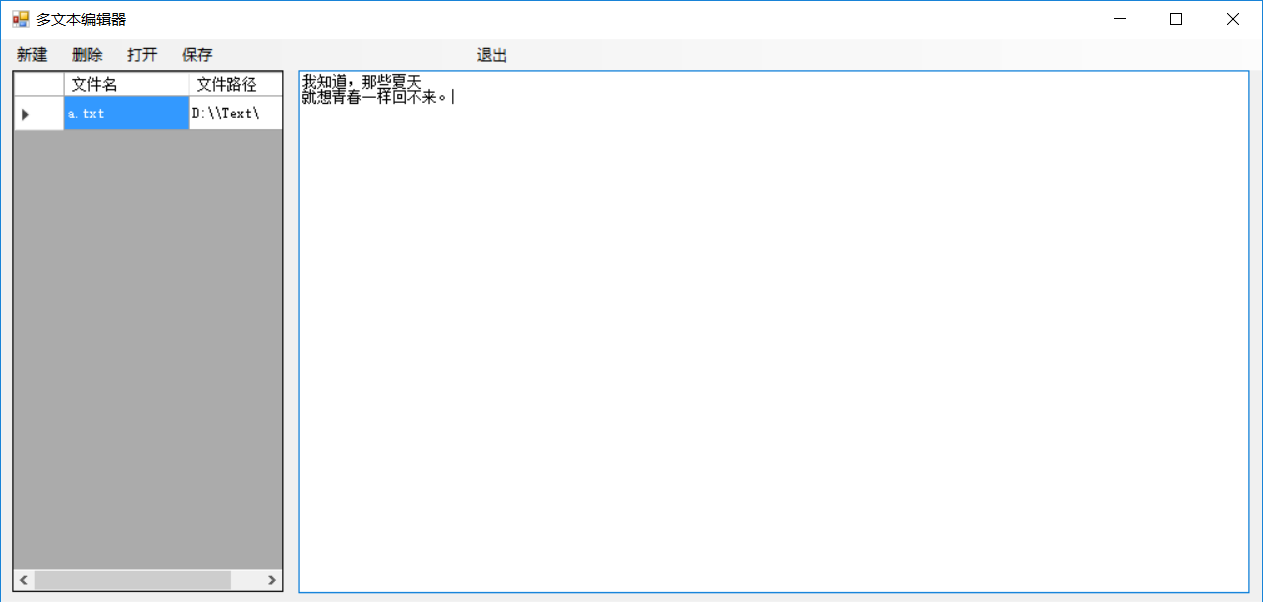
using System;
using System.Collections.Generic;
using System.ComponentModel;
using System.Data;
using System.Drawing;
using System.Linq;
using System.Text;
using System.Threading.Tasks;
using System.Windows.Forms;
using System.Data.SqlClient;
using System.IO;
namespace winformDemo
{
public partial class Form1 : Form
{
public Form1()
{
InitializeComponent();
//让textBox2隐藏
this.textBox2.Visible = false;
//让dataGridView1表中的最后一行空值隐藏掉
this.dataGridView1.AllowUserToAddRows = false;
}
SqlConnection con = new SqlConnection();
SqlCommand com = new SqlCommand();
OpenFileDialog open = new OpenFileDialog();
/// <summary>
/// 行
/// </summary>
string ClickRow = "";
/// <summary>
/// 列
/// </summary>
string ClickCells = "";
/// <summary>
/// 行和列相加的字符串
/// </summary>
string SqlLanding = "server=.;uid=sa;pwd=123456789;database=myfirstDemo";
private void dataGridView1_CellContentClick(object sender, DataGridViewCellEventArgs e)
{
//获取正在点击的行和列。
ClickRow = this.dataGridView1.Rows[e.RowIndex].Cells[0].Value.ToString();
ClickCells = this.dataGridView1.Rows[e.RowIndex].Cells[1].Value.ToString();
}
private void Form1_Load(object sender, EventArgs e)
{
SelectInfo();
}
public void SelectInfo()
{
//断开式链接查看数据库数据
con.ConnectionString = SqlLanding;
com.CommandText = "select Name as 文件名,TxtLuJing as 文件路径 from TxtBianJiQi";
com.Connection = con;
DataSet ds = new DataSet();
SqlDataAdapter sda = new SqlDataAdapter(com);
sda.Fill(ds);
this.dataGridView1.DataSource = ds.Tables[0];
}
private void 打开ToolStripMenuItem_Click(object sender, EventArgs e)
{
string Filepath = ClickCells + ClickRow;
this.textBox2.Visible = true;
try
{
//只读流;
FileStream fss = new FileStream(Filepath, FileMode.OpenOrCreate, FileAccess.Read);
StreamReader sww = new StreamReader(fss, Encoding.Default);
textBox2.Text = sww.ReadToEnd();
sww.Close();
fss.Close();
}
catch (Exception ex)
{
//如果没有选择路径提示出一句话;
MessageBox.Show("查看路径错误:" + ex.Message);
}
}
private void 保存ToolStripMenuItem_Click(object sender, EventArgs e)
{
string Filepath = ClickCells + ClickRow;
try
{
//只写流;
FileStream fss = new FileStream(Filepath, FileMode.Create, FileAccess.Write);
StreamWriter sww = new StreamWriter(fss, Encoding.Default);
sww.Write(textBox2.Text);
sww.Close();
fss.Close();
MessageBox.Show("保存成功!");
}
catch (Exception ex)
{
//如果没有选择路径提示出一句话;
MessageBox.Show("保存路径错误:" + ex.Message);
}
this.textBox2.Visible = false;
}
private void 新建ToolStripMenuItem_Click(object sender, EventArgs e)
{
this.textBox2.Text = "";
string localFilePath = "";
string fileNameExt = "";
string flie = "";
SaveFileDialog saveFileDialog = new SaveFileDialog();
//打开默认的文件目录
saveFileDialog.InitialDirectory = "D:\\\\Text\\";
//文件后缀名
saveFileDialog.Filter = "文本文件(*.txt)|*.txt|所有文件(*.*)|*.*";
saveFileDialog.FilterIndex = 2;
string LuJing = saveFileDialog.InitialDirectory;
if (saveFileDialog.ShowDialog() == DialogResult.OK)
{
flie = saveFileDialog.FileName;
//文件目录名
localFilePath = saveFileDialog.FileName.ToString();
//截取文件名字
fileNameExt = localFilePath.Substring(localFilePath.LastIndexOf("\\") + 1);
}
string sql = "select name from TxtBianJiQi";
SqlCommand co = new SqlCommand(sql, con);
SqlDataAdapter da = new SqlDataAdapter(co);
DataSet dss = new DataSet();
da.Fill(dss);
//循环判断传入的表中name
for (int i = 0; i < dss.Tables[0].Rows.Count; i++)
{
//定一个变量去接获取出来name
string ss = dss.Tables[0].Rows[i][0].ToString();
//判断对话框里输入的值是否与查出来的name相同
if (fileNameExt == ss)
{
MessageBox.Show("文件已更改!");
return;
}
}
try
{
//只写流
FileStream fs = new FileStream(flie, FileMode.Create, FileAccess.Write);
StreamWriter sw = new StreamWriter(fs, Encoding.Default);//对话框另存为。
sw.Write(textBox2.Text);
sw.Flush();
fs.Close();
con.ConnectionString = SqlLanding;
//往数据库添加 文件名和路径名 sql语句
com.CommandText = String.Format("insert into TxtBianJiQi(Name,TxtLuJing)values('{0}','{1}')", fileNameExt, LuJing);
com.Connection = con;
con.Open();
int insertInto = Convert.ToInt32(com.ExecuteScalar());
if (insertInto > 0)
{
MessageBox.Show("操作失败!请重试。");
}
else
{
MessageBox.Show("添加成功!");
this.textBox2.Visible = false;
}
}
catch (Exception ex)
{
MessageBox.Show("添加日志失败:" + ex.Message);
}
con.Close();
SelectInfo();
}
private void 删除ToolStripMenuItem_Click(object sender, EventArgs e)
{
con.ConnectionString = SqlLanding;
//从数据库删除正在点击的文件名
com.CommandText = String.Format("delete from TxtBianJiQi where Name='{0}'", ClickRow);
com.Connection = con;
con.Open();
DialogResult dr = MessageBox.Show("确认删除?", "提示", MessageBoxButtons.OKCancel, MessageBoxIcon.Information);
if (dr == DialogResult.OK)
{
int insertInto = Convert.ToInt32(com.ExecuteScalar());
if (insertInto > 0)
{
MessageBox.Show("操作失误!!");
}
else
{
//File.Delete(ClickCells + ClickRow);删除Windows里的文件,括号里是要删除文档的路径。
File.Delete(ClickCells + ClickRow);
MessageBox.Show("删除成功!");
}
}
con.Close();
SelectInfo();
}
private void 退出ToolStripMenuItem_Click(object sender, EventArgs e)
{
this.Close();
}
}
}
就是写了一个挺简单的在winform里进行填写文本,里面用到的ADO.NET来链接数据库,在新建文本的时候需要写入.txt后缀名,打开或者是删除的时候需要先点击一下文本名。 写的不足请见谅!